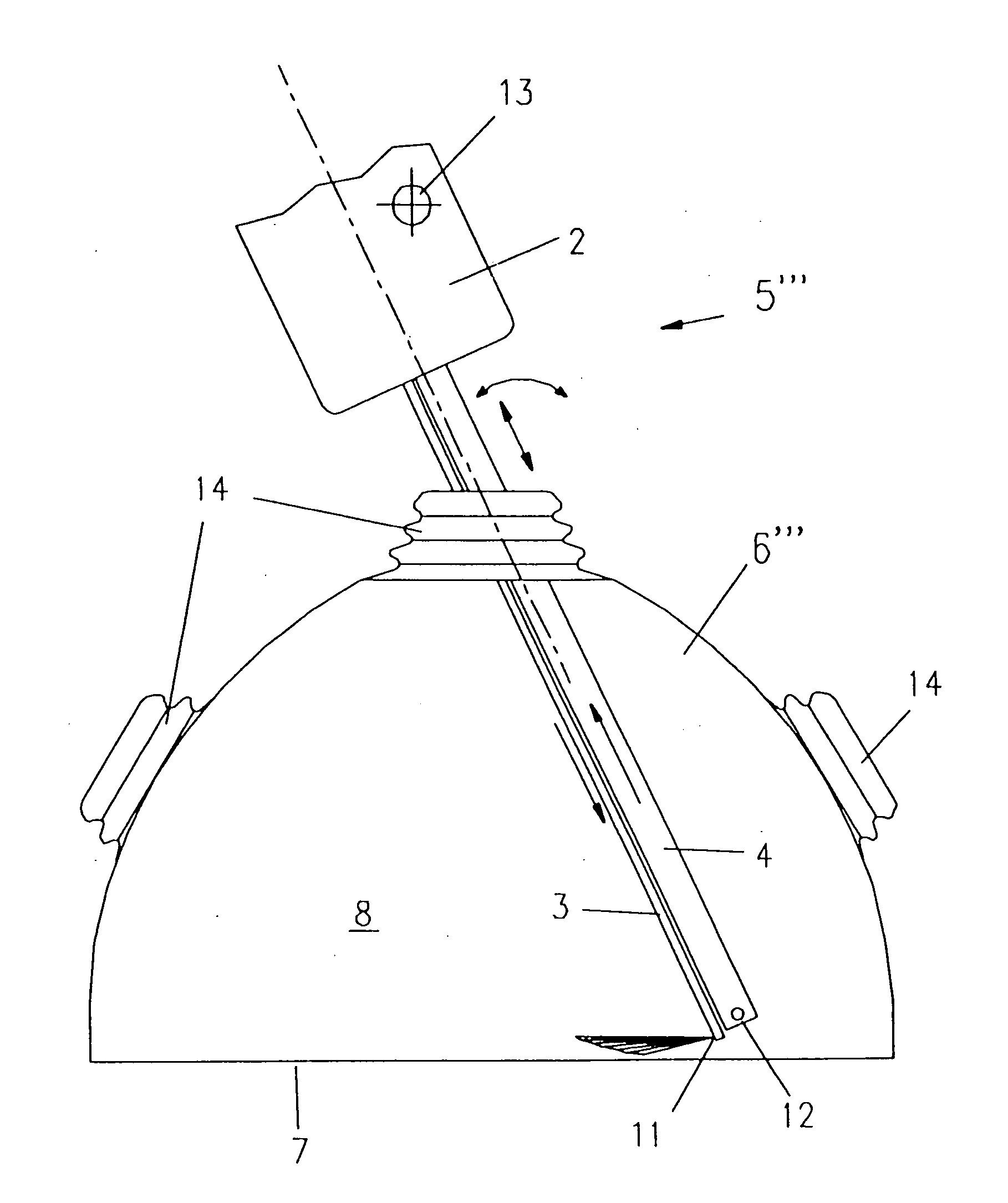Applicator for a water jet separating apparatus
a technology of water jet separating apparatus and water jet, which is applied in the field of application, can solve the problems of inability to effectively separate water jets, so as to facilitate the healing process, prevent the propagation of pathogenic microorganisms, and facilitate the healing process.
- Summary
- Abstract
- Description
- Claims
- Application Information
AI Technical Summary
Benefits of technology
Problems solved by technology
Method used
Image
Examples
first embodiment
[0036]In a first embodiment as shown in FIGS. 1 to 3, the work probe 5 has a flat protective cover 6 open downwardly and closed upwardly and to the sides. The protective cover 6 has a peripherally-extending sealing edge 7 on its open side facing downwardly. The sealing edge 7 can be adapted to the greatest extent possible to the shape of the body of the patient and is preferably equipped with a special sealing material which permits an airtight closure to the body surface. In this way, a hermetically closed off work chamber 8 is formed. The protective cover 6 comprises a transparent material in order to permit viewing into the work chamber 8 from the outside and therefore onto the work area. This protective cover 6 is preferably elongated and has a lateral surface 9 close to the handpiece 2 and a lateral surface 10 remote with respect to the handpiece 2. The pressure line 3 for the water jet opens laterally into the lateral surface 9 close to the handpiece 2 and forms a discharge no...
second embodiment
[0037]As shown in FIGS. 4 to 7, in the second embodiment, the work probe 5′ has, in the same manner, a handpiece 2 having a pressure line 3, a suction line 4 and a protective cover 6′ having a sealing edge 7. The pressure line 3 and the suction line 4 are, in turn, led laterally to the protective cover 6′. The protective cover 6′ is configured to be round when viewed in cross section and the pressure line 3 and the suction line 4 are guided on the periphery of the protective cover 6′. The peripherally-extending segment of the suction line 4 is disposed at the lowest plane and the pressure line 3 is disposed in the plane of the protective cover 6′ lying thereabove. For this purpose, preferably several suction openings 12 are uniformly distributed in the peripherally-extending segment of the suction line 4. As shown in FIG. 6, the pressure line 3 lying thereabove has four discharge nozzles 11, which are arranged uniformly offset, so that always two of the discharge nozzles 11 lie oppo...
third embodiment
[0041]The modified work probe 5″ of the third embodiment is shown in FIGS. 10 and 11 and has, in turn, a cylindrical protective cover 6″ which is made of a transparent material and which accommodates and encloses the pressure line 3 and the suction line 4 along the length in the distal region of the applicator 1. The protective cover 6″ is connected tightly to the handle 2. The pressure line 3 and the suction line 4 are arranged at a radial distance with respect to each other and to the cylindrical protective cover 6″ in such a manner that the ends of the pressure line 3 and the suction line 4 are arranged with respect to each other at the distal region at a largest radial distance. The pressure line 3 is closed at the end face with the discharge nozzle 11 being arranged radially at the outermost end of the pressure line 3. The discharge nozzle 11 is preferably a flat nozzle. The discharge nozzle 11 is directed in the direction of the end of the suction line 4. This end of the sucti...
PUM
 Login to View More
Login to View More Abstract
Description
Claims
Application Information
 Login to View More
Login to View More - R&D
- Intellectual Property
- Life Sciences
- Materials
- Tech Scout
- Unparalleled Data Quality
- Higher Quality Content
- 60% Fewer Hallucinations
Browse by: Latest US Patents, China's latest patents, Technical Efficacy Thesaurus, Application Domain, Technology Topic, Popular Technical Reports.
© 2025 PatSnap. All rights reserved.Legal|Privacy policy|Modern Slavery Act Transparency Statement|Sitemap|About US| Contact US: help@patsnap.com



